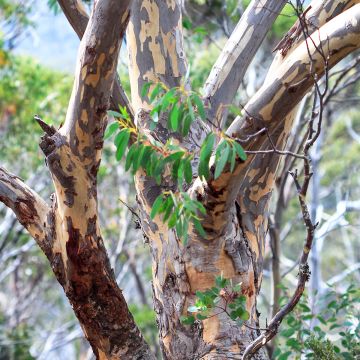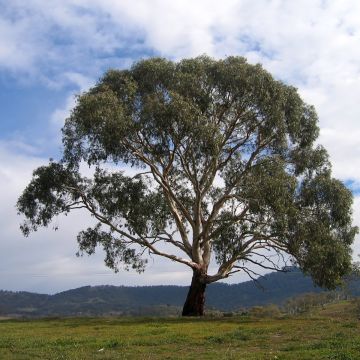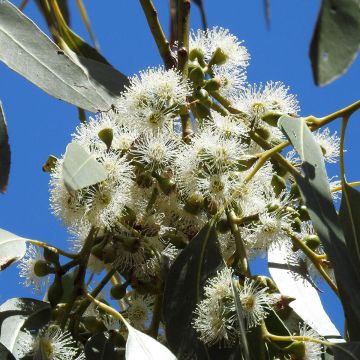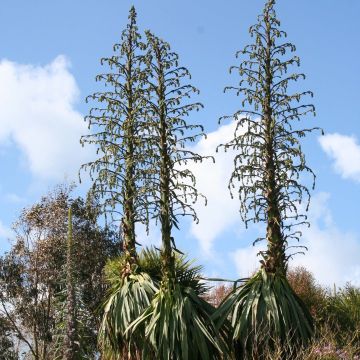

Eucalyptus camaldulensis Rostrata - Gommier rouge des rivières, Gommier de Camaldoli


Eucalyptus camaldulensis Rostrata - Gommier rouge des rivières, Gommier de Camaldoli


Eucalyptus camaldulensis Rostrata - Gommier rouge des rivières, Gommier de Camaldoli


Eucalyptus camaldulensis Rostrata - Gommier rouge des rivières, Gommier de Camaldoli
Eucalyptus camaldulensis Rostrata
Eucalyptus camaldulensis Rostrata
River Red Gum, Red Gum
We were looking for a specific variety of Eucalyptus and no garden centres offer it; only your website was able to deliver it to us and the delivery was made within the proposed timeframe: thank you for this quality service and the care in your work.
Dominique, 25/10/2023
Special offer!
Receive a €20 voucher for any order over €90 (excluding delivery costs, credit notes, and plastic-free options)!
1- Add your favorite plants to your cart.
2- Once you have reached €90, confirm your order (you can even choose the delivery date!).
3- As soon as your order is shipped, you will receive an email containing your voucher code, valid for 3 months (90 days).
Your voucher is unique and can only be used once, for any order with a minimum value of €20, excluding delivery costs.
Can be combined with other current offers, non-divisible and non-refundable.
Why not try an alternative variety in stock?
View all →This plant carries a 24 months recovery warranty
More information
We guarantee the quality of our plants for a full growing cycle, and will replace at our expense any plant that fails to recover under normal climatic and planting conditions.
Would this plant suit my garden?
Set up your Plantfit profile →
Description
Eucalyptus camaldulensis is an Australian species that is tall and grows very quickly. Widespread throughout Australia, it has also become very common around the Mediterranean. Its decorative bark and slightly bluish evergreen foliage make it popular as an ornamental tree. Undemanding in terms of soil, as long as it is not chalky, it grows in the sun. While it appreciates humidity, it is also capable of withstanding dry spells. Given its size, it is best reserved for large gardens, where it will make a beautiful specimen in isolation.
The Eucalyptus is a tree of the Myrtaceae family, like the Feijoa, Callistemon or Myrtle, with characteristic flowering of this family. The genus Eucalyptus, native to Australia, has more than 800 species, including the tallest deciduous trees in the world (E. regnans). The species E. camaldulensis is one of those with the widest distribution in Australia (rostrata is an old name related to the particular shape of the flower bud). It is a large tree that can exceed 40m (131 ft 2 in) in height, commonly growing along watercourses in semi-arid regions, hence its common name Red River Gum. The epithet "red" refers to the colour of its wood, which is used locally to make fence stakes, and also used by cabinetmakers for its unique colour. In Australia, it is a useful tree, providing timber and firewood, used for making pulp and dye with its red gum, and essential oils. Its bees produce highly sought honey.
Introduced to Europe 2 centuries ago thanks to seeds collected in 1817 in New South Wales, it is now the most widespread species in the Mediterranean, where it has adapted well, proving its good resistance to drought once established. It can reach 20 to 30m (65 ft 7 in to 98 ft 5 in) in height and 15 to 20m (49 ft 2 in to 65 ft 7 in) in width, developing a massive trunk over 1m (3 ft 4 in) in diameter at maturity which is straight or slightly twisted. Its bark is truly decorative, predominantly a light, grey-white, adorned with grey, green, and red, and regularly exfoliates. Rain particularly highlights these colours, making the trunks shiny.
Its evergreen foliage, ranging from green to grey-blue, takes on a different form depending on its maturity: the juvenile leaves are opposite, petiolate, oval to lanceolate, measuring about 8 to 18cm (3.1 to 7.1 in) long and 1.3 to 2.5cm (0.5 to 1 in) wide. The adult foliage is lanceolate to sickle-shaped and each leaf measures 5 to 30cm (2 to 11.8 in) long and 1 to 3cm (0.4 to 1.2 in) wide, also petiolate but alternately arranged on the branches.
Flowering occurs in March-April in the form of umbel inflorescences consisting of 7, 9, or 11 small flowers, with white to yellow stamens. Relatively inconspicuous compared to the tree's vegetative mass, it is primarily of interest for its honey production. Fruits that are small hemispherical capsules containing tiny brown-yellow seeds then develop. This species will self-seeding abundantly.
The Eucalyptus camaldulensis has great adaptability. It grows in a wide variety of soils, only disliking overly active limestone. Ideal for stabilizing riverbanks, it also withstands dry conditions quite well after the first few years of growth. Growing in full sun, it is moderately hardy and can withstand dry, brief cold spells of around -10°C (14 °F) under good conditions. It is also a tree that tolerates pruning very well, including severe pruning. A large trunk cut in summer will produce a clump of shoots before winter.
Eucalyptus camaldulensis makes a beautiful specimen to place in a large garden. It adds an undeniable touch of exoticism to the landscape, casting a light shade. It is mainly used in isolation due to its imposing size and because it competes strongly for water with other nearby plants (it is also suspected of producing inhibitory root substances towards certain other plants). It is perfect as a background plant in a large, exotic-inspired garden, where other Myrtaceae such as Metrosideros, with vibrant red-toned flowers, can also be found. A flowering Pomegranate tree, like Punica granatum California Sunset would also be well-suited in this type of setting.
Report an error about the product description
Plant habit
Flowering
Foliage
Botanical data
Eucalyptus
camaldulensis
Rostrata
Myrtaceae
River Red Gum, Red Gum
Australia
Other Eucalyptus
View all →Planting and care
Eucalyptus camaldulensis is best planted in early spring in a cool region and early autumn in a dry and hot climate. Plant in well-prepared, moist, occasionally dry soil, if possible non-chalky (acidic to neutral), in a warm and sunny location. A mature specimen is hardy down to -10°C (14 °F) in these conditions. Young plants are more sensitive to severe frosts, especially if the frost persists for several days and the soil is moist. In mild regions, you can plant it directly in the ground, ensuring sufficient drainage by adding coarse sand, pumice or non-chalky gravel. Water regularly during the first two years, especially in summer, and if it is particularly dry and hot. Pruning is unnecessary and even discouraged, to let the beautiful habit of this superb eucalyptus tree express itself. However, it is very well tolerated after flowering or at the end of summer. It is possible to train the eucalyptus into a single trunk, selecting the best-placed one and cutting all the others flush, but considering the beauty of its bark, it is better to let the tree branch out.
Gum trees are useful for draining wet areas, as they are heavy water consumers even in winter. However, they become quite drought-resistant once well established (to varying degrees depending on the species and varieties) and generally thrive in a Mediterranean-type climate.
Planting period
Intended location
Care
-
, onOrder confirmed
Reply from on Promesse de fleurs
Similar products
Haven't found what you were looking for?
Hardiness is the lowest winter temperature a plant can endure without suffering serious damage or even dying. However, hardiness is affected by location (a sheltered area, such as a patio), protection (winter cover) and soil type (hardiness is improved by well-drained soil).

Photo Sharing Terms & Conditions
In order to encourage gardeners to interact and share their experiences, Promesse de fleurs offers various media enabling content to be uploaded onto its Site - in particular via the ‘Photo sharing’ module.
The User agrees to refrain from:
- Posting any content that is illegal, prejudicial, insulting, racist, inciteful to hatred, revisionist, contrary to public decency, that infringes on privacy or on the privacy rights of third parties, in particular the publicity rights of persons and goods, intellectual property rights, or the right to privacy.
- Submitting content on behalf of a third party;
- Impersonate the identity of a third party and/or publish any personal information about a third party;
In general, the User undertakes to refrain from any unethical behaviour.
All Content (in particular text, comments, files, images, photos, videos, creative works, etc.), which may be subject to property or intellectual property rights, image or other private rights, shall remain the property of the User, subject to the limited rights granted by the terms of the licence granted by Promesse de fleurs as stated below. Users are at liberty to publish or not to publish such Content on the Site, notably via the ‘Photo Sharing’ facility, and accept that this Content shall be made public and freely accessible, notably on the Internet.
Users further acknowledge, undertake to have ,and guarantee that they hold all necessary rights and permissions to publish such material on the Site, in particular with regard to the legislation in force pertaining to any privacy, property, intellectual property, image, or contractual rights, or rights of any other nature. By publishing such Content on the Site, Users acknowledge accepting full liability as publishers of the Content within the meaning of the law, and grant Promesse de fleurs, free of charge, an inclusive, worldwide licence for the said Content for the entire duration of its publication, including all reproduction, representation, up/downloading, displaying, performing, transmission, and storage rights.
Users also grant permission for their name to be linked to the Content and accept that this link may not always be made available.
By engaging in posting material, Users consent to their Content becoming automatically accessible on the Internet, in particular on other sites and/or blogs and/or web pages of the Promesse de fleurs site, including in particular social pages and the Promesse de fleurs catalogue.
Users may secure the removal of entrusted content free of charge by issuing a simple request via our contact form.
The flowering period indicated on our website applies to countries and regions located in USDA zone 8 (France, the United Kingdom, Ireland, the Netherlands, etc.)
It will vary according to where you live:
- In zones 9 to 10 (Italy, Spain, Greece, etc.), flowering will occur about 2 to 4 weeks earlier.
- In zones 6 to 7 (Germany, Poland, Slovenia, and lower mountainous regions), flowering will be delayed by 2 to 3 weeks.
- In zone 5 (Central Europe, Scandinavia), blooming will be delayed by 3 to 5 weeks.
In temperate climates, pruning of spring-flowering shrubs (forsythia, spireas, etc.) should be done just after flowering.
Pruning of summer-flowering shrubs (Indian Lilac, Perovskia, etc.) can be done in winter or spring.
In cold regions as well as with frost-sensitive plants, avoid pruning too early when severe frosts may still occur.
The planting period indicated on our website applies to countries and regions located in USDA zone 8 (France, United Kingdom, Ireland, Netherlands).
It will vary according to where you live:
- In Mediterranean zones (Marseille, Madrid, Milan, etc.), autumn and winter are the best planting periods.
- In continental zones (Strasbourg, Munich, Vienna, etc.), delay planting by 2 to 3 weeks in spring and bring it forward by 2 to 4 weeks in autumn.
- In mountainous regions (the Alps, Pyrenees, Carpathians, etc.), it is best to plant in late spring (May-June) or late summer (August-September).
The harvesting period indicated on our website applies to countries and regions in USDA zone 8 (France, England, Ireland, the Netherlands).
In colder areas (Scandinavia, Poland, Austria...) fruit and vegetable harvests are likely to be delayed by 3-4 weeks.
In warmer areas (Italy, Spain, Greece, etc.), harvesting will probably take place earlier, depending on weather conditions.
The sowing periods indicated on our website apply to countries and regions within USDA Zone 8 (France, UK, Ireland, Netherlands).
In colder areas (Scandinavia, Poland, Austria...), delay any outdoor sowing by 3-4 weeks, or sow under glass.
In warmer climes (Italy, Spain, Greece, etc.), bring outdoor sowing forward by a few weeks.























































